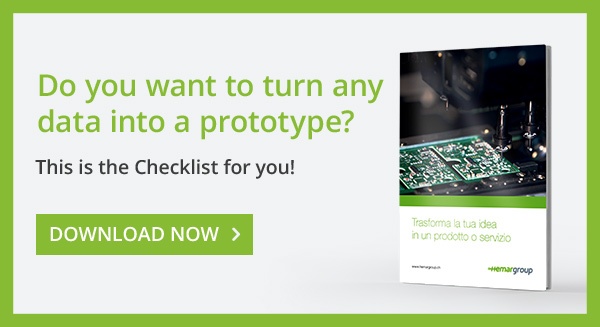
Startups that adopt the IoT for their business are gaining a competitive advantage over those who are unable (or unwilling!) to adapt to evolving technologies.
The IoT facilitates digital transformation at companies that collect data from a range of devices that are not easily accessible or are difficult to monitor or repair continuously.
The integration of the IoT into a wide range of industries, including those characterized by large labor forces, is helping to modernize the workforce, commercial strategies, and the very culture of companies that adopt it. And this gives them an undeniable competitive advantage over other market players that are slower or more hesitant to tackle change.
In the case of startups, the IoT guarantees flourishing prospects for the future and offers a way to make the brand stand out and position itself as a newcomer on the market.
Let's have a look at some practical applications with Hemargroup.
Innovative startups: focus on the IoT
We're now firmly convinced that the IoT is the next industrial revolution, that of large-scale digital transformation. Startup companies implement new technologies (including not just the IoT, but also big data, cloud computing , and machine learning) in business processes to become more efficient and competitive.
After the manufacturing, technological, and digital revolutions, today we are seeing industry 4.0 (the fourth revolution), with the IoT at the forefront. Companies automate tasks and make business improvements based on massive amounts of data.
If the IoT is the engine driving this revolution, then cloud and edge computing, big data, and mesh networks are what fuels it.
Each of these revolutions made the industries involved drastically less labor intensive and the IoT has already begun to do the same. It also allows companies to behave more intelligently, making informed and proactive decisions based on concrete data.
The IoT has led to a massive influx of data and the ability to collect and disseminate even more. Personal devices, such as mobile phones and tablets, wearables, and smart homes, as well the adoption of smart technologies in the workplace, indicate that there is a huge potential for new electronics businesses, now more than ever. And this is because we are finally opening the doors to this kind of advantage.
Considering that on top of this we have cloud computing, big data tools, and analytics technologies (as well as emerging ones such as edge computing and mesh networks), it seems crystal-clear that startups will get faster and faster at collecting, storing, and analyzing this data and using it to gain a competitive advantage.
Practical applications of the IoT are already underway in a number of sectors and opportunities to evolve are on the rise. For example, farmers can now use sensors to monitor the health of their crops and yield in order to optimize results, instead of relying on the knowledge and habits of the past, weather forecasts, and their intuition and courage!
A prime example of this is the company xFarm, which aims to provide a new platform for the agriculture of the future and to collect the data necessary for this purpose through its product xSense. Manufacturing companies can monitor machine performance using digital twins; these enable them to take a proactive rather than just reactive approach, thereby eliminating unnecessary downtime and inefficiencies among employees. Finally, the whole production chain can be certified in this way, providing end customers with a high level of quality and safety and thus promoting customer loyalty.
Let's dive into the transformative impact that the IoT can have in a startup by analyzing some micro trends for 2019.
IoT startups: micro trends for 2019
Mesh networks
A mesh network is an interconnected communication network consisting of several devices: in practice, these are repeaters that boost Wi-Fi signal, thus improving reception and extending the signal.
Have you ever been browsing comfortably on the sofa in the living room one minute, then lost signal when you move a few steps to the kitchen the next? And let's not even get started on the office... This is what can happen with a conventional router. A mesh network replaces a single router with lots of small devices that boost the signal immediately. Furthermore, if one of the individual devices goes down, the network compensates for the signal transmission. If your home router or even the area repeater stops working, on the other hand, it's goodbye signal!
These networks are fundamental to the widespread success of the IoT, as they allow devices to be connected to a strong and reliable signal. Mesh networks affect performance, which is critical for a company that potentially invests millions in its network of machines or connected devices. A small-scale example of a mesh network would be a smart home with lights, thermostats, and ceiling fans connected to each other. On a large scale, one example would be a 40,000-acre wind farm, where even the furthest turbine is connected with a signal just as strong as the one next to the power station.
Edge computing
This is an open mesh network in which the processing power is decentralized; i.e. the server processes all data directly at the local level, without first transferring it to the centralized warehouse. A shining example of this technology in use is found in driverless cars. The flow of data is accelerated, processing takes place almost instantly in the creation phase, and this drastically reduces both delays and margins of error.
For startups, this translates into:
-
Reduced bandwidth usage
-
Lower costs
-
Maximum efficiency of remote applications.
No data is also transferred to the public cloud, which also increases the security of sensitive data.
The evolution of edge computing centers around IoT sensors and shifts much of the processing close to the sensors themselves to increase their efficiency. Since IoT devices are also present in areas where the connection is unreliable, edge computing reduces the amount of time it takes to store and process data, given that processing takes place before the data reaches the cloud or data center.
Digital twins
These are virtual "copies" of physical objects and processes. They are extremely useful because they enable technicians and engineers to perform tests to improve functionality and avoid errors. Think of what goes on inside a factory, for example: digital twins make it is possible to collect data in real time about the production process in progress and thereby understand what needs to be changed, what needs maintenance, and so on.
It was Nasa that first introduced digital twins to monitor and predict the operation of its satellites. Today, digital twins are revolutionizing the production chain of startups and enabling us to create products that perfectly match the requirements of potential consumers. Digital twins enable you to conduct tests and make smarter, better-informed decisions in the digital world before implementing them in the physical world.
The result? A 50% saving on time and a 20% increase in production (source: Gartner study).
Such sensors can collect hundreds of thousands of data points every day, but companies cannot truly take advantage of the benefits unless they are able to analyze this data (and then use it strategically in future business processes). Sensor data often needs to be associated with other types of information, such as image or video analyses, geo-location tags, and the interactions of human beings in the environment with those objects (in the context of the collected data).
IoT analysis is often managed by business intelligence platforms, which help to combine sensor data with other company data, for example from the ERP system, CRM software, or supply chain series. Since sensors can produce large volumes of data, competent advice and effective big data analytics tools are the fastest way to help companies assimilate trends and prepare information so it can be displayed as understandable and prototypable data.
.png)
